He built a rammed earth ecological house in Anji, and also opened a "mud school" (part two)
Zhao yajing
As soon as the heat brought by the award passed, the eco-house fell into a state of lack of attention. The government has still not promoted eco-houses as model houses. In 2012, the director of Anji County New Rural Construction Guidance Center said: "Ren Weizhong’s concept is modern and too avant-garde. Maybe people with high cultural level can appreciate it, but the people in Anji have not reached this level."
This may be true. Farmers still build villas and do not agree with Ren Weizhong’s ecological houses. In 2009, patches of cement-built farmers’ relocated houses and villas surrounded the eco-house base into an island.
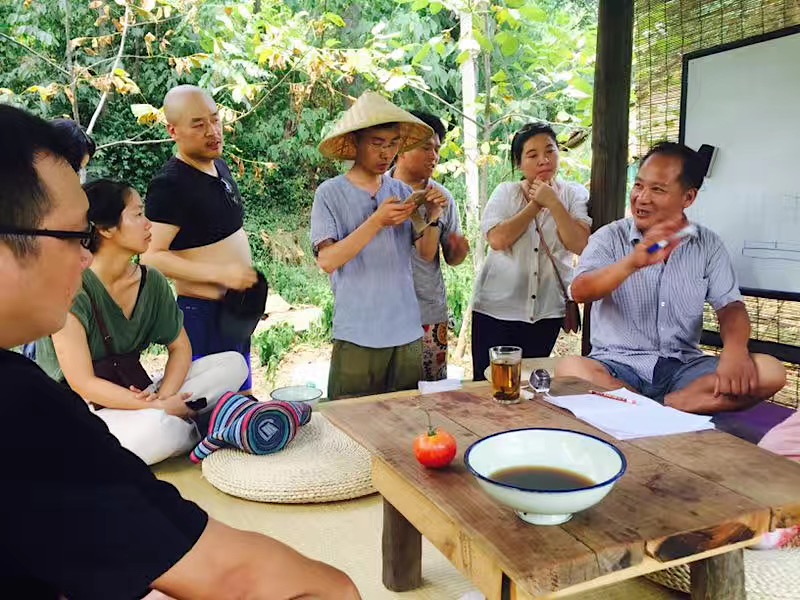
Ren Weizhong teaches "Tujing" in Zhongnanshan, Shaanxi. Image source: WeChat WeChat official account, Wutuwu Township (2017)
Spreading rammed earth technology in "mud school"
But Ren Weizhong didn’t give up. As the saying goes, there is a thousand-year-old earth wall, but there is no hundred-year-old brick wall. Since 2012, he has calmed down and devoted himself to doing a lot of experiments to study the performance of rammed earth and refine its ingredients.
He tried different proportions of rammed earth materials for each house in order to find out the best structural proportion of materials and solve the common wall cracking problem in traditional rammed earth buildings. The low rammed earth wall in the yard of the base has different colors and textures, which is also the experimental body of rammed earth performance. In addition, he also explored the use of soil, developed the use of light clay as thermal insulation material, and tapped the decorative properties of soil. The plaster mixed with lime and soil developed by him shows the touching texture of Italian plaster.
From 2005 to 2014, the eco-house had no income for ten years, and Ren Weizhong was unwavering. After three years of research and development experiments, in 2015, he sold the first mud plastering material, and the situation opened. He began to serve as the soil technical director of some well-known homestay projects, and his rammed soil technology is also being used in Qinghai ancient city protection project. Rammed earth materials are also used in the memorial hall where the theory of "two mountains" was published by General Secretary of the Supreme Leader of Yu Village in Anji.
"I remember when I was a child, my house was expanded, and the wall material was mud, and the soil as a raw material was dug around the house, and the transportation distance was only tens of meters. This material can be transported by hand. A few years after the house was built, the pit that we had dug was slowly filled with the baptism of years, and no traces left by earth borrowing were found at all. After being abandoned, the earthen houses will be razed to the ground after being eroded by wind and rain, so it is difficult for you to find the ruins of these old houses. Everything comes from the earth and returns to the earth. This example fully proves the harmony between man and nature, and the construction process of this earth house has almost no energy consumption and will not pollute the environment. "
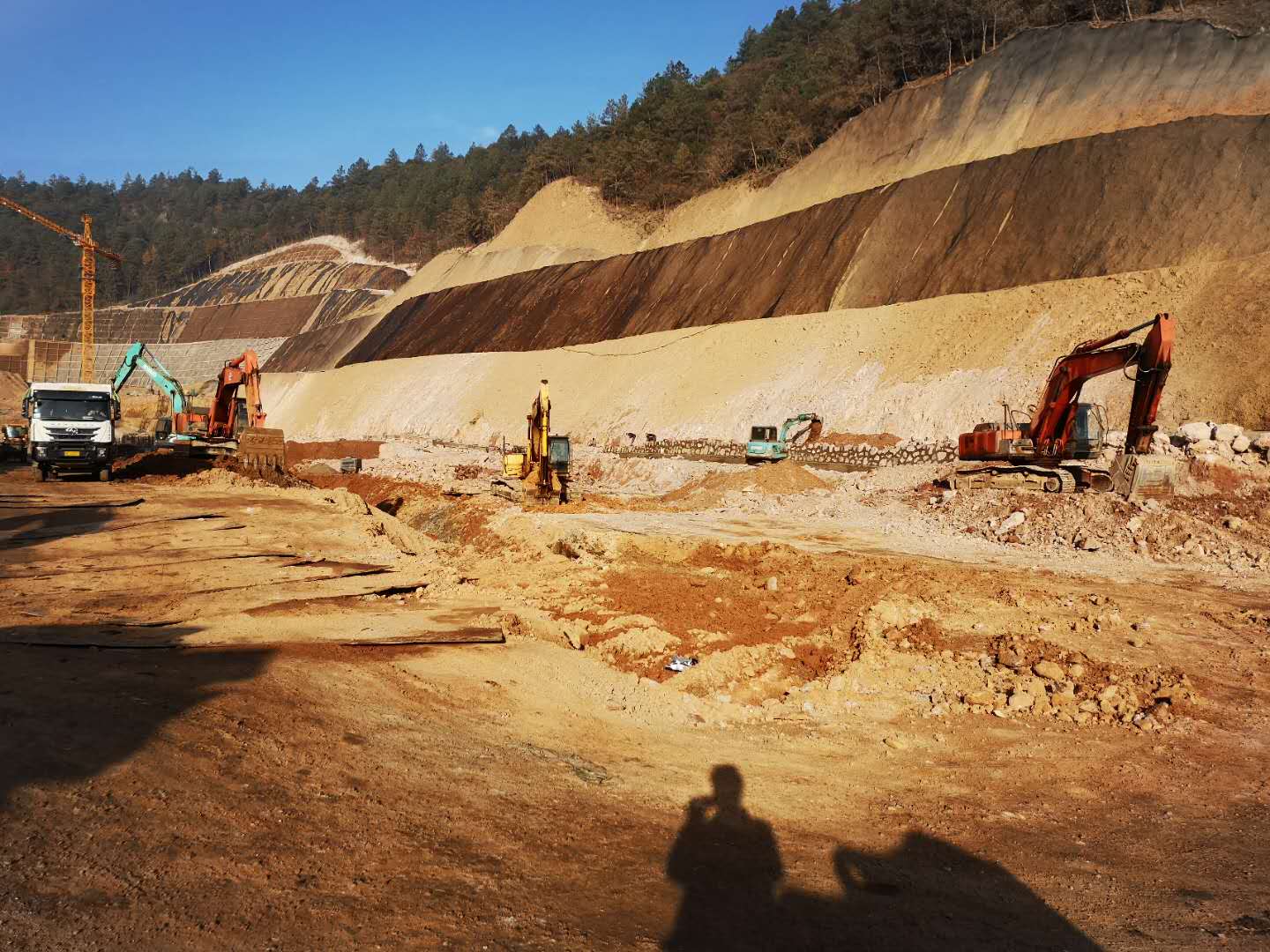
A large amount of construction muck is produced on the construction site, which becomes the source of building materials for rammed earth houses.
Some professionals question that the clay used in rammed earth construction will cause the loss of valuable clay resources. Ren Weizhong explained that rammed soil comes from the residual mud and dregs of the construction site, which is neither cultivated soil nor clay, but a kind of sandstone soil. "The waste soil residue on these construction sites is worthless when it is not used, and it even becomes a stacking problem." Ren Weizhong said.
In 2015, the muck mountain in Shenzhen Guangming New District Industrial Park collapsed, causing 22 buildings to be buried, causing a particularly serious safety accident. The problem of the acceptance and accumulation of construction dregs has attracted the attention of the State Council. There are also building dregs in rural areas now, so rammed earth houses can digest the wastes from these construction projects.
In the past, houses were built in rural areas, so a big pit was often dug at the head of some villages, and water was poured into the pit to turn it into a pond for raising fish. But today’s soil is not from the pit at the head of the village, but from the foundation pit of the construction site. He often emphasizes that building a house is to borrow soil from nature, and finally the house is demolished and the soil is returned to nature.
In recent years, more and more people know about Ren Weizhong, and the ecological environment has been paid more and more attention by the government and all walks of life. Every time I go to Jianshan Village to see him, there are always visitors. He also accepted apprentices and hired people to assist in the daily operation of the ecological base. When there are many guests, his wife will go to the kitchen to help cook, and his son will play in the base yard.
He is no longer a "army of one". He has his own family and successfully established his own team. These people include both local villagers and young people from other places. These workers also look very hardworking and simple. When they sat around a table for dinner at noon, they showed the harmonious atmosphere of the family. The main hall in Room 1 now doubles as a restaurant for visitors, and all the lectures are transferred to Room 2.
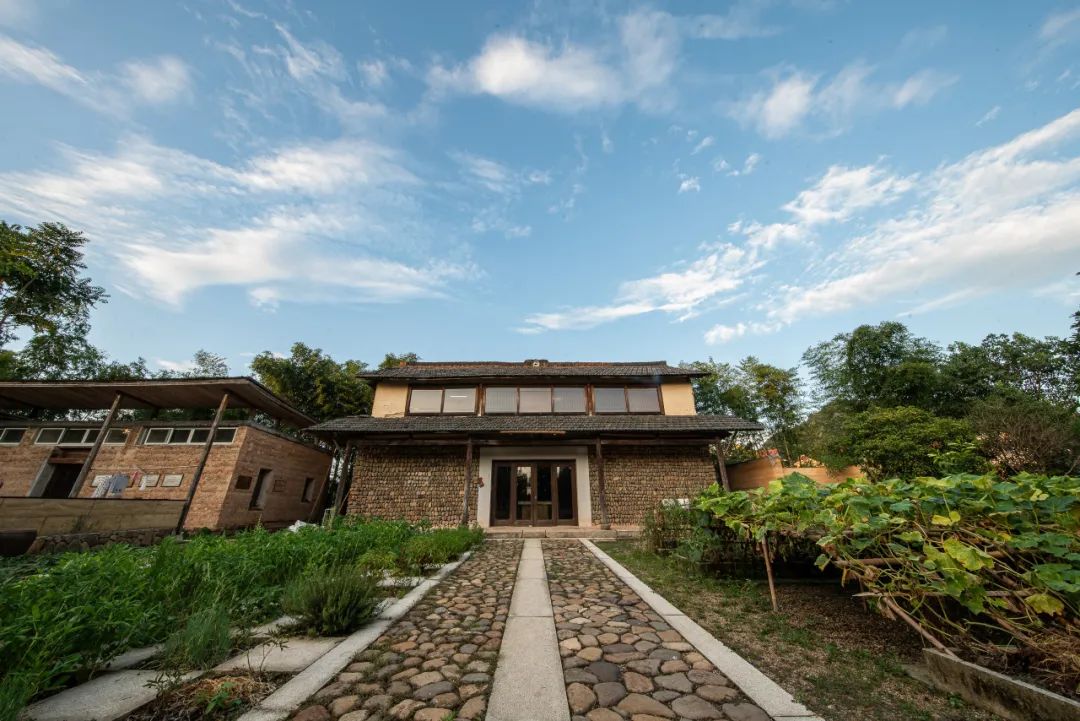
House No.2 Image Source: Jushe Image WeChat WeChat official account (2019)
The two-story stone-wood house facing the gate of the base is the second ecological house, and it is also a house that makes me shine at the moment. On the second floor, a large area of windows facing south is opened to introduce sufficient light. The scale of this house is friendly and pleasant, and the colors of old wood, old tiles and stone rammed earth are naturally mixed together. The whole house is like an antique gentleman, low-key and modest. Well-proportioned proportion and classical and simple temperament made me realize for the first time that Ren Wei, who looks like a native soil, actually has a high aesthetic taste.
House 2 is also the most sacred house in Renwei Center, which he called "Mingtang". The upper floor of the house is used for lectures and training, and the wooden frame comes from the old house where the captain’s family used to be produced. The ground floor is used to show the research results of rammed earth building materials. Like the mineral exhibition platform of the Natural Museum, rammed earth blocks with different proportions are carefully cut into small square bricks and lined up neatly. Mud has become the protagonist of this exhibition hall, because it is the soul of the "mud school".
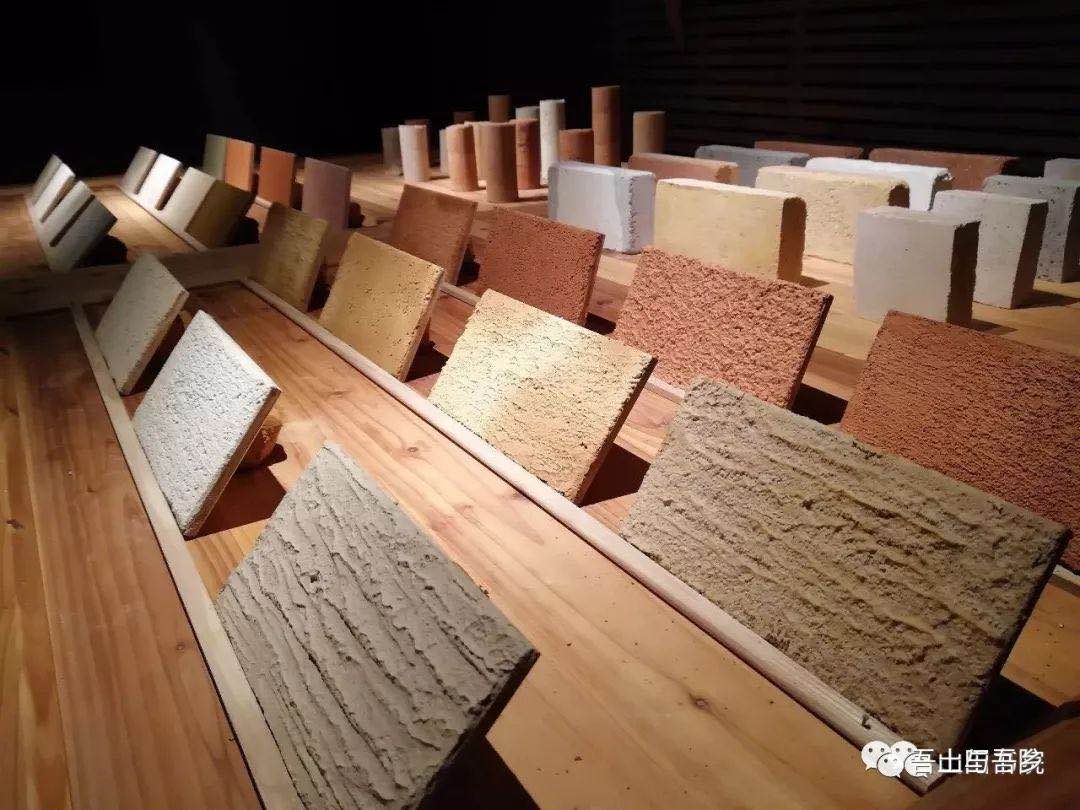
Rammed earth R&D materials exhibition platform Image source: Wechat WeChat official account, Wutu Wuxiang (2019)
"The reason why I am particularly fond of soil is mainly because soil is a particularly environmentally friendly material. Efficient and wasteful building activities in the industrial age may make all kinds of resources in short supply, especially the ecological damage and environmental pollution built in the process of resource mining and material processing cannot be tolerated. However, the earth is the only one with the richest soil, and the soil building will not change the performance of the soil, so it can be recycled. It’s just that at present, we lack common sense and have misunderstandings about soil. It can be said that the purpose of practice is partly to vindicate soil, and soil can also build high-quality houses. As for why mud buildings are rarely taken seriously, it is mainly unprofitable behind them. "
Ren Weizhong’s ecological residential practice focuses on rammed soil, which is not only the natural result of exploring ecological construction, but also the result of the overall environment.
One summer in 2007, Gao Tiancheng, a South African, rented a villager’s empty house in Sanjiuwu, Laoling Village, Moganshan Town, and renovated it with the concept of low carbon and environmental protection on the basis of not changing the original house structure and destroying the overall style. He established the bare-hearted hometown of homestay, which became the birthplace of "foreign music" in China, and opened the prelude to the rapid development of homestay industry in Moganshan. In the process of setting up a homestay, Gao Tiancheng went deep into the rural areas of Zhejiang to learn about the local construction ecology. He also visited Ren Weizhong’s ecological house. In 2015, the hotel industry in Moganshan entered its peak period, and the Moganshan effect drove the hotel fever in the country.
Boutique B&B caters to the mentality of the urban middle class returning to nature and pursuing a high-quality life. Rammed soil has become a popular building material for homestays. This makes rammed earth technology have its place. More and more people ask Ren Weizhong about rammed earth construction technology.
In 2016, he changed the name of "Jianshan Ecological House" to "Mud School" and began to teach students. In August 2016, the first phase of rammed earth training started. Ten times a year, about 180 students can be trained every year. Training fees are priced for public welfare, only to spread rammed earth technology. Some other students stayed and became his assistants.
In 2017, Ren Weizhong won the public welfare grant of "March towards ecological civilization and pay tribute to environmental pioneers" jointly sponsored by China Environmental Protection Foundation and China Foundation for Poverty Alleviation, to train rural craftsmen, returnees and school students, and plans to replicate the model of mud schools in different places. Therefore, in the past two years, he has become more and more busy, and the workers in the "clay school" workshop are busy from sunrise to sunset. After the mud school became famous, the villagers in Jianshan Village said that it was finally set up by him, and the feng shui of this base was good.
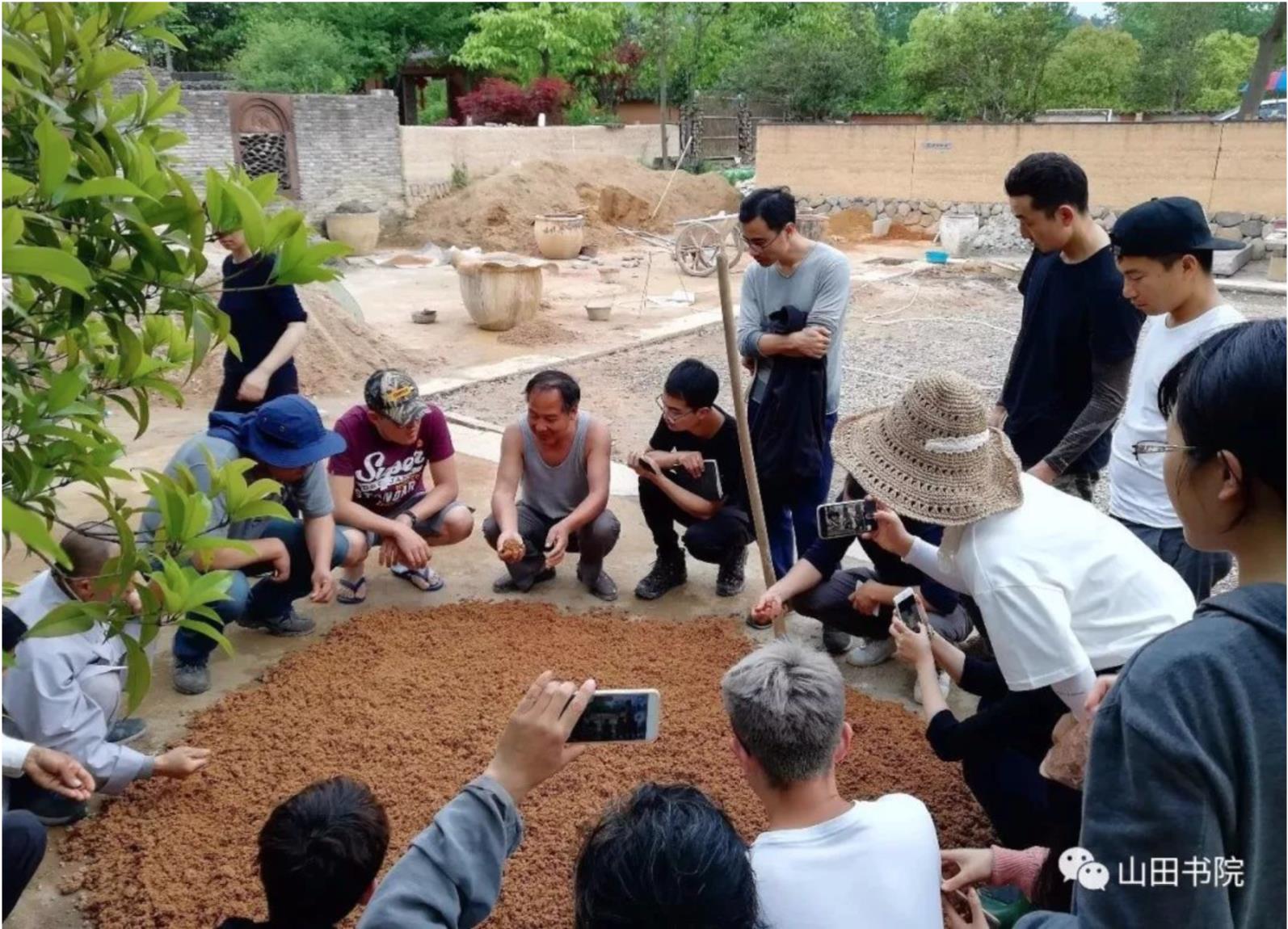
Ren Weizhong teaches at the rammed earth construction workshop. Photo source: Shantian Academy WeChat WeChat official account (2019)
Rammed soil has become "noble", pushing up the cost of building houses. I asked Ren Weizhong, who is bent on building houses for farmers, how to solve this problem? He said that rammed earth is expensive in manpower, and the traditional way of building houses in rural areas of China was completed by people in the village helping each other, which can be solved by restoring the way of building houses by mutual assistance. However, due to the loss of young people in rural areas, it seems that the road to restoring mutual-aid housing is long. But the historical process is mysterious and unpredictable. Who knows? Once a thing is regarded as advanced, it will go through the process from the small crowd to the public. Ren Weizhong may have taken a curved road to save the country.
In order to let people experience rammed earth buildings personally, Ren Weijian built House 3. There are four rooms on the upper and lower floors, which provide accommodation for the trainees. The whole house adopts simple modern design, with rammed earth for bearing.
In June of 2020, I was lucky enough to stay for one night. The thin long windows have a European flavor, and the simplest bed and chairs make me feel like I walked into a simple European country cottage. There are only three kinds of building materials in the room: wood, mud and glass. There is no superfluous decoration. Directly exposed mud wall, meet each other with sincerity, the yellow and gray tone, like the warm chest of the earth, feels delicate and smooth, and looks like a texture between cement and paint. The room exudes the aesthetic temperament of simplicity and minimalism.
It’s just an ordinary guest room, but it reminds me of Donald Judd, an American minimalist artist, who used metal plates to create meaningless object forms, showing the high purity of materials. This purity is exactly what I felt in Room 3. But unlike Donald Judd, all the object forms and spaces here point to the essence of soil.
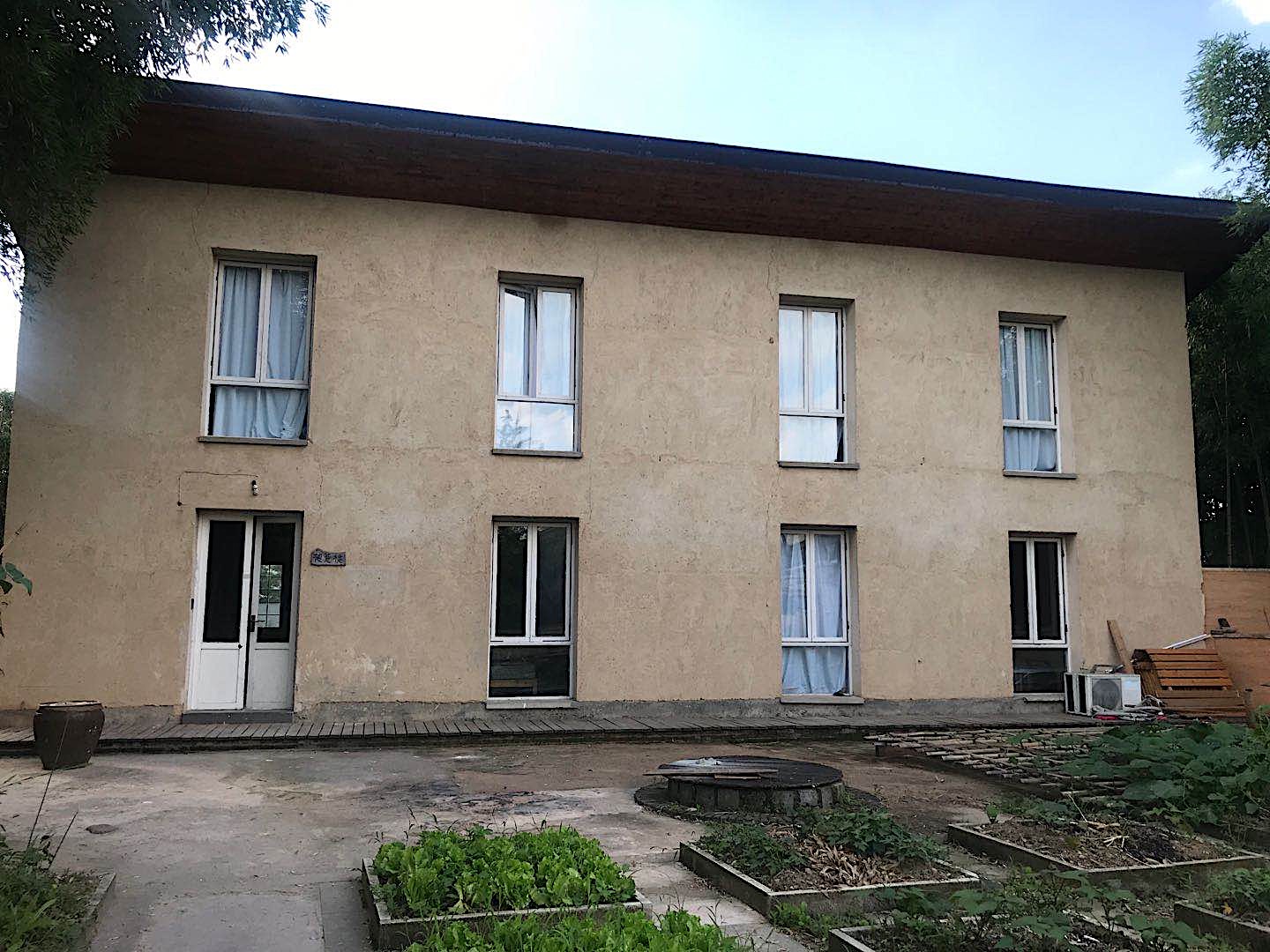
Zhao Yajing’s photo of the facade of House No.3 (2020)
In the early morning, I got up early, and the freshest air in the yard came to my face. There are no less than 10 kinds of vegetables planted in 5 rows, 6 rows and 30 squares. Walking along the path of the yard, the ground is as hard as cement, but it is a dirt road. The two jars of lettuce on the outside of the vegetable garden are full of green, and the cucumber vines on the inside have already been picked out. A line of tomatoes was planted along the low wall, and the fresh red fruits hung down from the leaves. Going over a row of low walls, Ren Weizhong designed a checkerboard-style vegetable bed. Step by step, growing vegetables is like playing chess. Not far from the granary, chicken coop and handmade tofu workshop. Ren Weizhong explained the original intention of designing these auxiliary facilities. "In my mind, the village should first be self-sufficient economically, at least food can be produced by itself, instead of relying on the market, and then it can establish a resource cycle, do not produce garbage, and reduce the burden on the environment."
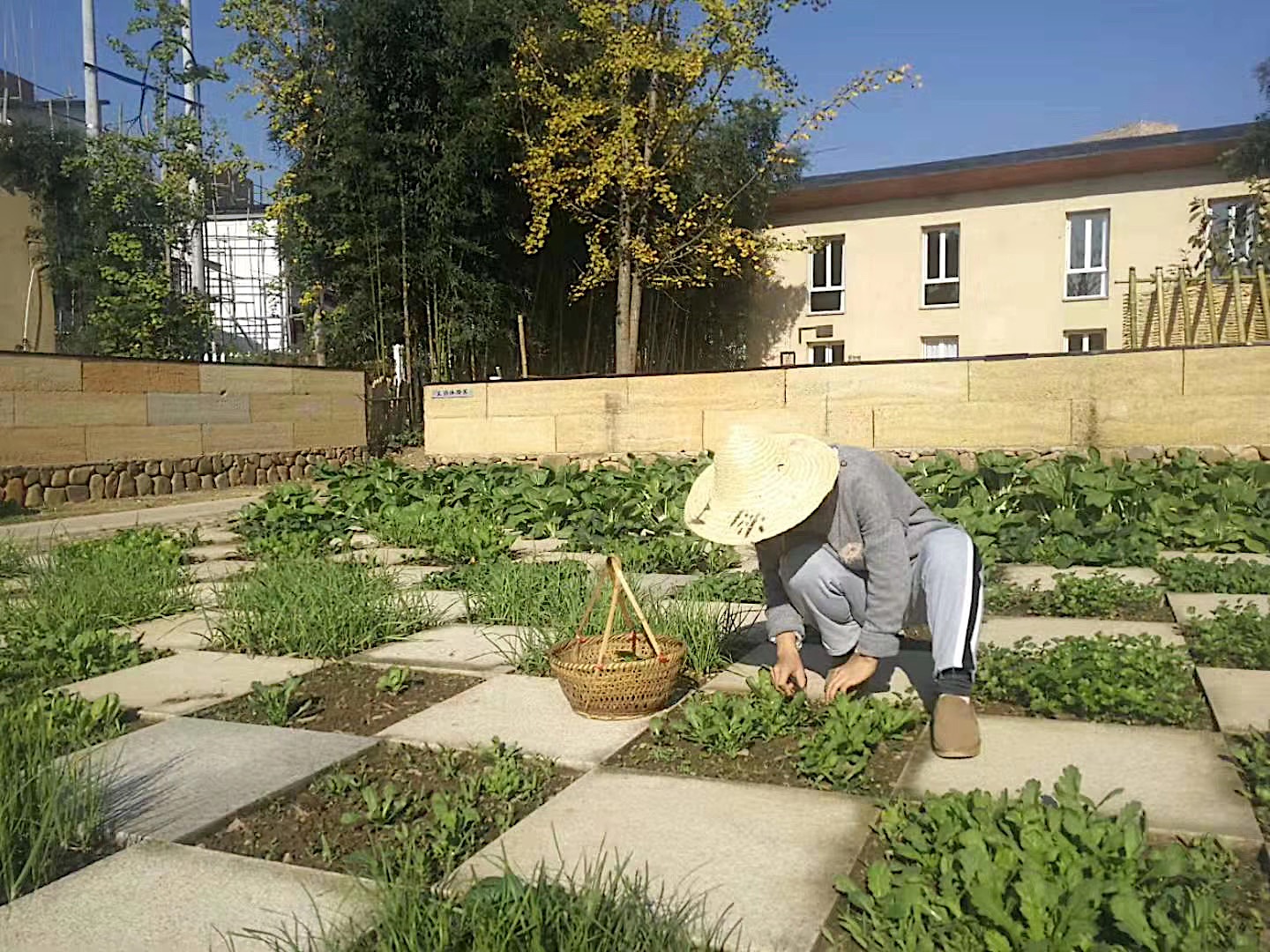
Checkerboard Garden Ren Weizhong/Photo in 2019
He integrated biogas and solar energy into the energy used in the ecological house, and also improved Anji’s traditional iron pot bath, which is a multi-purpose firewood stove for burning pig grass and bathing in the pigsty.
At the beginning of the century, families in Anji Mountain Village did not have shower rooms. Firewood stove and iron pot bath are rural living facilities that make us Shanghai high school students feel incredible. People wash in the pot and the firewood burns under it. Isn’t that person a stewed pig’s trotters? The students are all afraid to try iron pot bath. Only one naughty boy tried it. He excitedly reported the first bath experience, and it was very comfortable to bathe in an iron pot with a diameter of nearly one meter. However, when he was drunk, the pig on the side screamed, which scared him to start from a pot of water and ended in a mess. The improved iron pot bath still retains the firewood stove, but it is moved from the pigsty to the bathroom. Ren Weizhong’s son became the first person who tried to wash the pot, and the little guy sang with the happy bath water. I found that his interior design was inspired by traditional rural life. He often mentions the details of his childhood life. In a sense, Ren Weizhong acted like an independent contemporary artist, building an ideal "Utopia" on the barren beach.
The dream of an agricultural ecological village with unchanging initial intention
"I have always had the greatest wish, that is, to build an ecological village where people and nature live in peace, and no longer let buildings that consume a lot of cement and steel bars and are not in the middle of the ocean occupy precious land. This idea is my dream that I have been struggling for more than ten years."
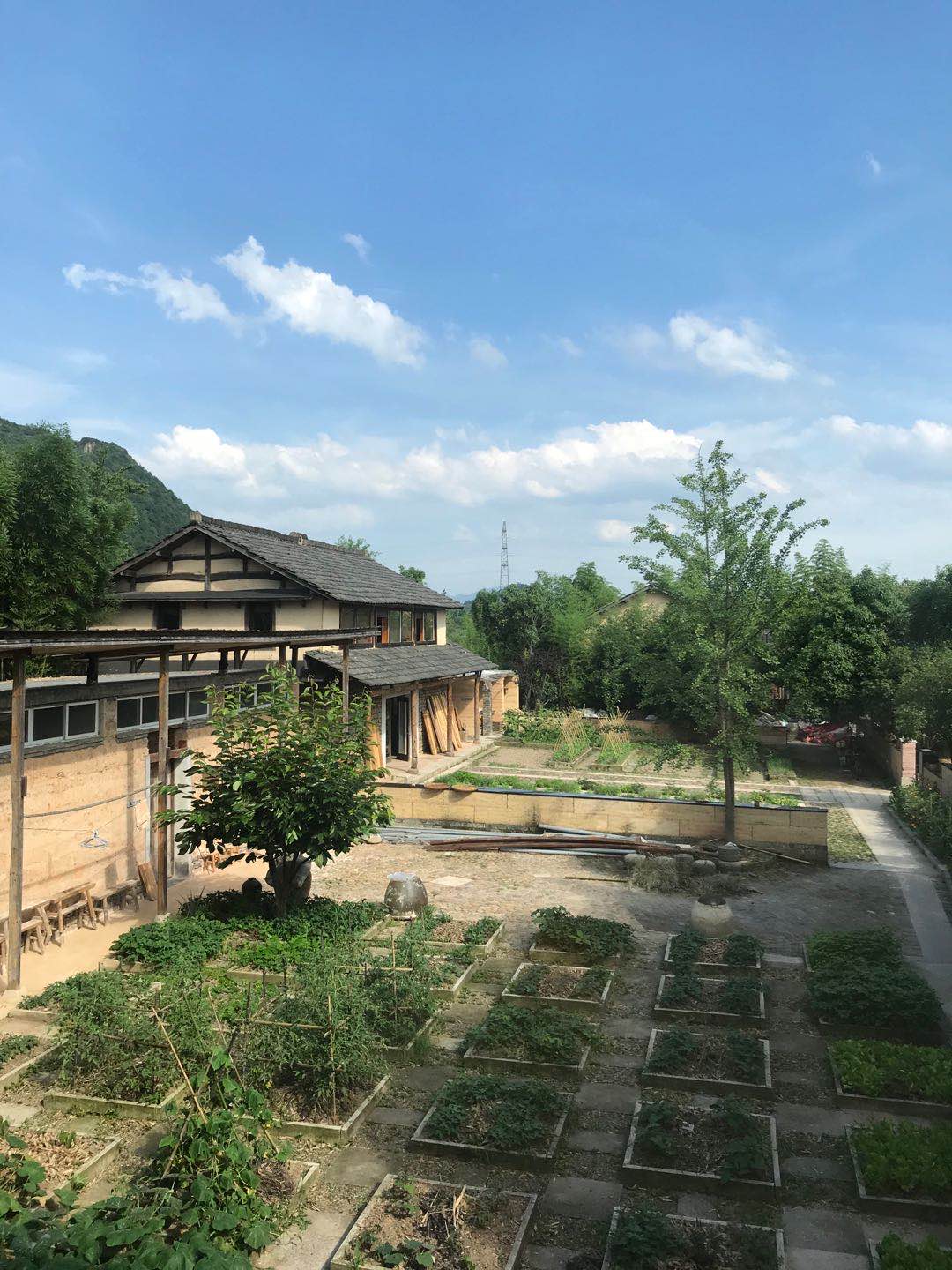
Bird’s-eye view of vegetable garden in house 3 (2020) Zhao Yajing
On that midsummer night 19 years ago, in the farmhouse yard at the foot of the mountain in Tongli Village, Ren Weizhong talked to my classmates and me about this dream of building a village. We felt that this man was still dreaming at his age. Over the years, I have taken my friends to visit the "mud school" every year, and everyone was deeply moved by his work. What Ren Weizhong wants to do most is to build an agricultural ecological demonstration village, popularize environment-friendly rural housing, and at the same time realize that the village economy does not depend on the city, and all kinds of resources circulate internally, and take the mode of sustainable development. The inspiration of the eco-village comes from Dazhai, taking the spirit of self-reliance, hard work and collectivism in Dazhai.
Although it seems difficult to achieve the goal of eco-village, times have changed and everything has developed in a favorable direction. First of all, Ren Weizhong built the rural ecological house and improved the core rammed earth construction technology. Ecological residence is regional, and rammed earth building materials are universal. From eco-house to rammed earth construction technology, Ren Weizhong put forward a solution to make eco-house universal, and entered the market through homestay buildings, which was connected with people’s real life. In this sense, Ren Weizhong is somewhat like a building materials developer.
Secondly, people’s ideas in rural society are constantly evolving. From the perspective of construction practice, modern building materials such as reinforced concrete have entered the countryside for more than 30 years. In the process of long-term living and use, the problems of these building materials are gradually exposed, and the countryside is also learning lessons, constantly reflecting and improving the construction of houses. The way of sticking tiles on the external walls of houses in the 1990s has been eliminated. However, the popularization of rammed earth buildings needs to solve some technical and cost obstacles. Farmers hope to build houses high, but rammed earth houses with more than two floors are facing the test. In addition, the labor cost of rammed earth building is high, how to reduce the cost? Whether it is feasible for farmers to build houses with mutual assistance under the trend of urbanization is unknown. From the perspective of living concept, the situation is changing. The transformation and upgrading of the homestay industry gives rural society the opportunity to intuitively feel the ecological living, get in touch with the architectural concept of low-carbon and environmental protection, and reshape the understanding of earth houses. This is a slow and gradual process. The field of self-built houses in rural areas is a fully competitive free market, and farmers will make rational choices, but how to guide farmers to build houses also tests the vision and wisdom of the government.
During the construction of "beautiful countryside", some local governments in rural areas of Zhejiang Province promoted the construction of model farmhouses, notably Wencun Village, Dongqiao Town, Fuyang District, Hangzhou City, Zhejiang Province, which was designed and built by Wang Shu, winner of Pritzker Architecture Prize. There is also Dazhuyuan Village in Anji, which was designed and constructed by Du Chunyu’s design team of Shanghai Jiaotong University Design and Research Institute. The project won the award of "2016 National Rural Housing Pilot Demonstration" by the Ministry of Housing and Urban-Rural Development.
Whether the design of modern rural model houses is good or not, rural society will naturally give feedback. Rural society should be more confident, based on its own experience, and put forward solutions to rural residential modernization. Just like Ren Weizhong, the scheme extracted from tradition may not be perfect at first, but it can be improved in many ways in the future. Farmhouses designed by western architects, urban architects or local people will eventually be tested by rural society. Ren Weizhong’s rammed earth architecture is still improving, and rural society needs more time to digest and understand his ideas and practical achievements.
The evolution of social concepts is inseparable from "potential", which requires observing the trend from the interaction between urban and rural areas. In 1984, farmers began to work in cities. For more than 20 years, farmers moved to cities to build cities. Around 2010, China ushered in a wave of rural construction. Many urban intellectuals, artists, urban white-collar workers, entrepreneurs and even foreigners went to various villages in China to help villages and villagers improve their living conditions and rebuild rural order through various ways, such as poverty alleviation teaching assistants, protection of ancient buildings, revival of folk arts, ecological agriculture, tourist hostels and reconstruction of rural cultural life. The rural construction in China shows the rich appearance of a hundred flowers blooming, and there is a case of "Yangjiale" naked heart township igniting the residential industry. Who knows whether there are future industrial opportunities in these various rural construction projects?
Urban people flow to the countryside, build the countryside, dig deep into various rural resources and develop creative projects, which bring opportunities for rural economic employment, and rural local rural builders like Ren Weizhong benefit from it. However, even if there is a qualitative change in the concept of living and construction in rural society, the realization of the ideal of building an ecological village still depends on the return of population from rural areas, so it depends on the general trend of the national economy and the trend of globalization. In such an era of crisis, the vast countryside can become a safe haven. The agricultural eco-village advocates ecological construction, is self-sufficient in economy, realizes resource circulation in the village, and farmers live independently of the city. This idea provides a solution to the crisis for the society. It is the hope of the countryside that bits and pieces of rural construction projects resonate together on the land of China. It is the mainstay of the times for farmers like Ren Weizhong to stick to the local position from beginning to end and seek the way out of rural modernization from tradition.
In a media interview, Ren Weizhong pointed to House No.2 in Mingtang in his heart and said easily, "The pebbles on the wall come from the stream in front of the door. In the future, when this house is demolished, the stones can be returned to the stream." The amateur architect has no obsession with architecture, and his philosophy is Taoist. Everything comes from nature and finally returns to nature. This is the belief and methodology of Ren Weizhong’s ecological and environmental protection cause. There is a cloud in the Book of Songs, "Peace and happiness". Anji has been a beautiful place since ancient times. This is the source of Ren Weizhong’s simple concept. Yes, what could be more divine than nature?
Reference catalogue
1. "Anji Ecological Watcher", Zhao Xiao, 2007, China Environment News.
URL: http://www.eedu.org.cn/Article/epedu/epman/200702/11891.html
2. Ford Motor Environmental Award official website URL: http://cegc.npi.org.cn/about/award.html
3. "Farmers who can’t build houses are not good architects", Jin Yanqi, 2015, No.74 of Designer magazine.
URL: https://wenku.baidu.com/view/cba72f4458f5f61fb73666d4.html
4. China Building Media Award official website
URL: http://nd.oeeee.com/cama/200811/t20081127_921211.shtml
6. Ren Weizhong’s "Yu Gong" in building an ecological village, Huang Rong, 2012, Green China magazine.
URL: http://www.greenchina.tv/news-508.xhtml
7. Anji Environmental Education Base
URL: http://ajnews.zjol.com.cn/ajnews/ajepb/hj/effect/index.htm
8. "Huzhou Anji" Clay School "pushes energy-saving technology to the whole country", Yu Ying and Wang Weili, 2017, Huzhou Daily.
URL: http://zj.people.com.cn/n2/2017/0918/c186947-30745160.html